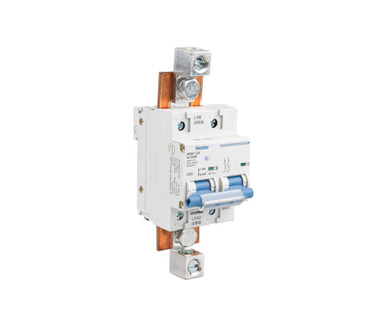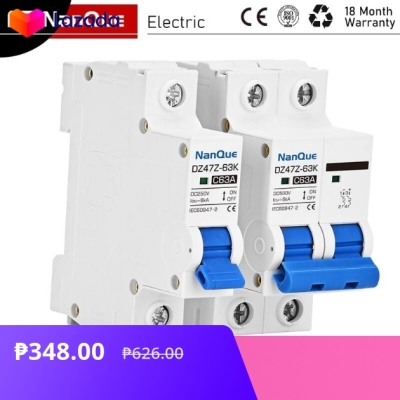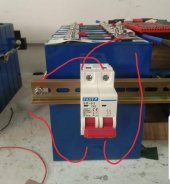You are using an out of date browser. It may not display this or other websites correctly.
You should upgrade or use an alternative browser.
You should upgrade or use an alternative browser.
Dual pole DC breaker on + side
- Thread starter dddem
- Start date
Goboatingnow
Solar Enthusiast
- Joined
- Jul 3, 2022
- Messages
- 1,325
No , cause you can’t be sure how the current will split up.
Assuming same length and gauge wire and decent crimps, it should be close imo?No , cause you can’t be sure how the current will split up.
John Frum
Tell me your problems
- Joined
- Nov 30, 2019
- Messages
- 15,233
Here is your proof of concept.

 signaturesolar.com
signaturesolar.com

Nader DC Circuit Breaker | 60V 200Amp
Signature Solar provides solar panels, off-grid solar systems, grid-tie, and hybrid systems. Quality solar inverters, bifacial solar panels, complete solar kits, solar batteries. Featuring brands such as EG4 Electronics with their solar battery, LifePower4 and EG4 LLifePower4 and EG4 LL
 signaturesolar.com
signaturesolar.com
Goboatingnow
Solar Enthusiast
- Joined
- Jul 3, 2022
- Messages
- 1,325
You can’t be sure and hence you could subject the breaker to over it’s rated capabilityAssuming same length and gauge wire and decent crimps, it should be close imo?
It is polarized, as per the schematic that is printed on it. Which is why I want to wire it that way.Make sure the breaker is non-polarized.
I can wire it that way and put a test load on it and measure that the currents are approximately equal with an ampmeter.You can’t be sure and hence you could subject the breaker to over it’s rated capability
John Frum
Tell me your problems
- Joined
- Nov 30, 2019
- Messages
- 15,233
Batteries support bi-directional current flow.It is polarized, as per the schematic that is printed on it. Which is why I want to wire it that way.
"Polarised DC circuit breakers use a small magnet to direct the arc away from the contacts and up into the arc shoot and arc disrupter cage. If the direction of current flow through the unit is reversed, then the magnet directs the arc away from the arc shoot and into the mechanism of the unit thus destroying it. This discussion paper details: (i) the common mistakes installers are making when wiring the polarised breakers; (ii) how the polarised breakers work and how they are wired correctly. The main difference between polarised and non-polarised breakers is that the polarised breakers will typically have a marking on them showing a ‘+’ and ‘–‘ symbol." -- http://greenforcesolar.com.au/wordp...of-Double-Pole-DC-Breakers-LVL2-131210-v2.pdf
Yes I agree but a catastrophic discharge current (short circuit on the load side) seems a lot more likely than a catastrophic charge current (other than maybe from lightning, which the PV circuit should be protected against)?Batteries support bi-directional current flow.
"Polarised DC circuit breakers use a small magnet to direct the arc away from the contacts and up into the arc shoot and arc disrupter cage. If the direction of current flow through the unit is reversed, then the magnet directs the arc away from the arc shoot and into the mechanism of the unit thus destroying it. This discussion paper details: (i) the common mistakes installers are making when wiring the polarised breakers; (ii) how the polarised breakers work and how they are wired correctly. The main difference between polarised and non-polarised breakers is that the polarised breakers will typically have a marking on them showing a ‘+’ and ‘–‘ symbol." -- http://greenforcesolar.com.au/wordp...of-Double-Pole-DC-Breakers-LVL2-131210-v2.pdf
Last edited:
John Frum
Tell me your problems
- Joined
- Nov 30, 2019
- Messages
- 15,233
I see your point.Yes I agree but a catastrophic discharge current (short circuit on the load side) seems a lot more likely than a catastrophic charge current (other than maybe from lightning, which the PV circuit should be protected against?
John Frum
Tell me your problems
- Joined
- Nov 30, 2019
- Messages
- 15,233
I see a second battery on your bench.
Are these two batteries to connected in parallel?
If yes and one of them has an internal short, the shorted battery will see big current in the wrong direction.
The other battery's OCPD should trip though.
A melted breaker is better than a venting battery.
Are these two batteries to connected in parallel?
If yes and one of them has an internal short, the shorted battery will see big current in the wrong direction.
The other battery's OCPD should trip though.
A melted breaker is better than a venting battery.
True and very good point.I see a second battery on your bench.
Are these two batteries to connected in parallel?
If yes and one of them has an internal short, the shorted battery will see big current in the wrong direction.
The other battery's OCPD will trip though.
A melted breaker is better than a venting battery.
Are class T fuses non-polarized?
John Frum
Tell me your problems
- Joined
- Nov 30, 2019
- Messages
- 15,233
@ddem do you know of a primer on the diagrams breakers?
To the best of my knowledge yes.True and very good point.
Are class T fuses non-polarized?
Although it could be argued that the directional breaker on the good battery would prevent its discharge into the shorted one...I see a second battery on your bench.
Are these two batteries to connected in parallel?
If yes and one of them has an internal short, the shorted battery will see big current in the wrong direction.
The other battery's OCPD should trip though.
A melted breaker is better than a venting battery.
Non polarized dc breakers seem hard to come by.
John Frum
Tell me your problems
- Joined
- Nov 30, 2019
- Messages
- 15,233
Yes it could and I didAlthough it could be argued that the directional breaker on the good battery would prevent its discharge into the shorted one...
Non polarized dc breakers seem hard to come by.
chess-equality
Solar Enthusiast
- Joined
- May 21, 2022
- Messages
- 500
Non polarized dc breakers seem hard to come by.
For MCBs it might be; MCCBs (molded case) are usually non-polarized (but more expensive).
This one's got 20kA breaking capacity:
Suntree DC 160A MCCB Molded Case Circuit Breaker
High quality Suntree DC 160A MCCB Molded Case Circuit Breaker from China, China's leading Suntree 160A MCCB product, with strict quality control 160A Molded Case Circuit Breaker factories, producing high quality Suntree 160A Molded Case Circuit Breaker products.
www.mcbcircuitbreakers.com
I live in Asia so most of the stuff we get is Chinese. Many DC MCB say "non polarized" yet they show + and - symbols on the schematic so what gives!?
Example here:

 s.lazada.com.ph
s.lazada.com.ph
Example here:

Check out DC Circuit Breaker DC MCB 250V 500V 750V 1000V 1...at 44% off!₱348.00 only!Get it on Lazada now!
at 44% off!₱348.00 only!Get it on Lazada now!
 s.lazada.com.ph
s.lazada.com.ph
chess-equality
Solar Enthusiast
- Joined
- May 21, 2022
- Messages
- 500
I live in Asia so most of the stuff we get is Chinese. Many DC MCB say "non polarized" yet they show + and - symbols on the schematic so what gives!?
Me too; I think the polarity can be checked by a meter.
Mine's got "1-2-3-4" markings and no polarity symbols, also doesn't say in the manual.
chess-equality
Solar Enthusiast
- Joined
- May 21, 2022
- Messages
- 500
Similar threads
- Replies
- 1
- Views
- 208
- Replies
- 5
- Views
- 252






